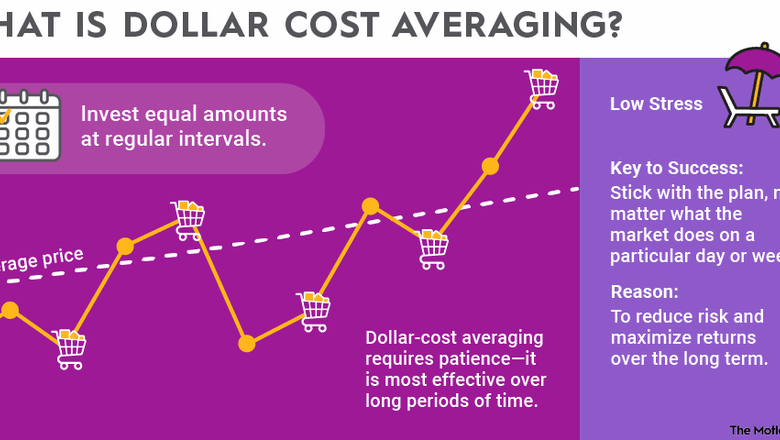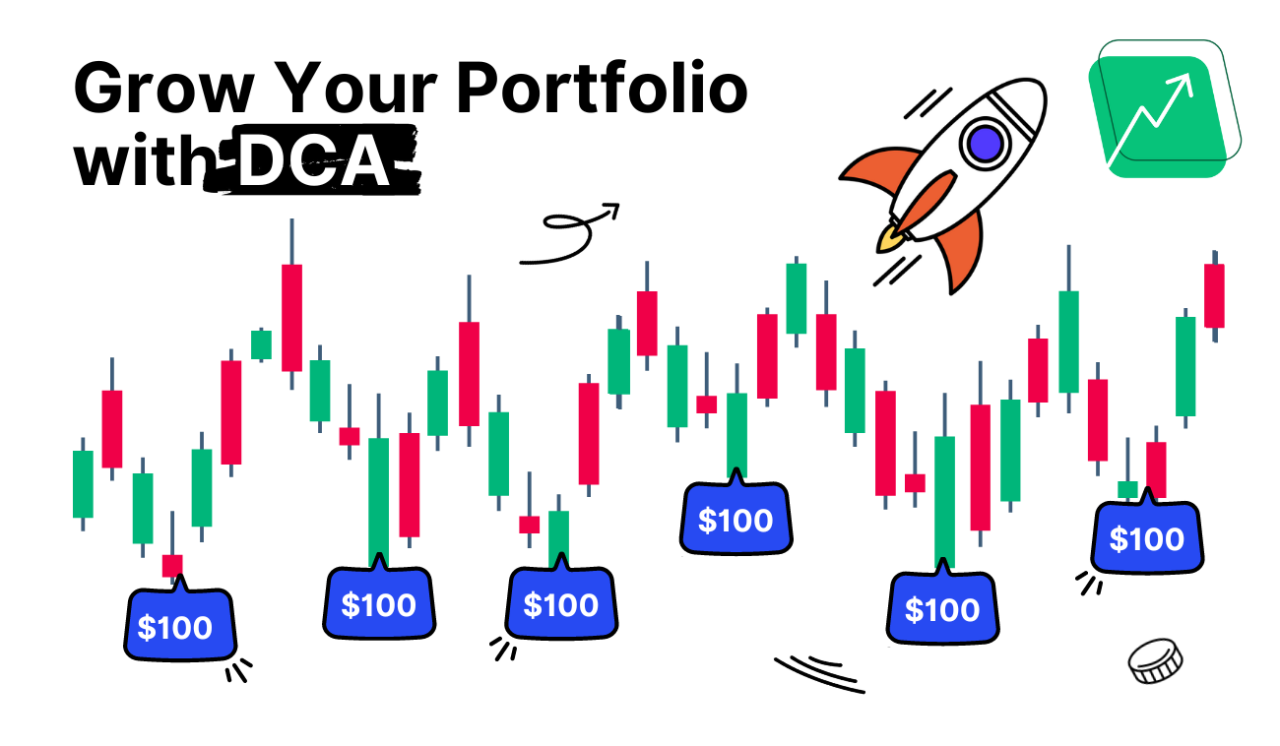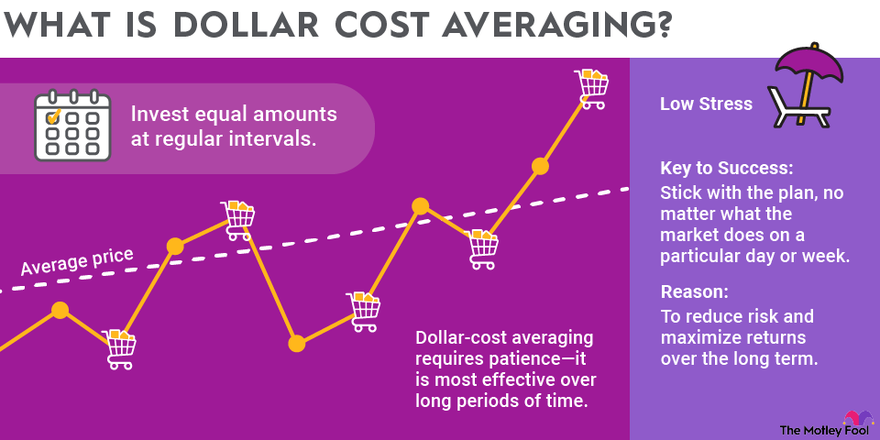
How to Use Dollar-Cost Averaging for Crypto Investments
How to Use Dollar-Cost Averaging for Crypto Investments lays out a strategic approach to navigating the often-volatile crypto market. This method, known as DCA, allows you to buy cryptocurrency regularly, regardless of price fluctuations, potentially reducing risk and increasing long-term returns. We’ll delve into the fundamental concepts, practical applications, and potential pitfalls of using DCA for your crypto portfolio.
Dollar-Cost Averaging (DCA) is a popular investment strategy that can be particularly useful for crypto investments. It helps investors avoid making emotional decisions based on short-term market swings by setting up a regular investment schedule. This systematic approach can provide a more disciplined and potentially less stressful investment experience.
Introduction to Dollar-Cost Averaging (DCA)
Dollar-Cost Averaging (DCA) is a popular investment strategy that helps investors manage risk and potentially smooth out market fluctuations. It involves investing a fixed amount of money at regular intervals, regardless of the market price of the asset. This consistent approach can be particularly useful for long-term investments, especially in volatile markets like cryptocurrency.The fundamental concept behind DCA is to buy more of an asset when its price is low and fewer when its price is high.
This strategy, over time, can average out the purchase price of the asset, potentially leading to a more favorable outcome than trying to time the market perfectly. It’s a disciplined approach that focuses on consistent investing rather than trying to predict market peaks and troughs.
Dollar-cost averaging (DCA) is a great strategy for crypto investments, letting you buy regularly regardless of price fluctuations. However, to truly maximize your returns, understanding the tokenomics behind a particular cryptocurrency is crucial. For example, knowing the token’s utility and the potential for future development can greatly impact your investment decisions. By combining DCA with a deep dive into tokenomics, like exploring Why Understanding Tokenomics Can Increase Your Crypto Gains , you’re better equipped to make informed choices and potentially ride the wave of growth.
This approach allows you to stay disciplined with your DCA strategy, and focus on the long-term potential of the crypto you’re investing in.
How DCA Differs from Other Investment Strategies
Unlike strategies that involve significant lump-sum investments or trying to predict market highs and lows, DCA offers a steady, consistent approach. This avoids the risk of investing a large amount of capital at a potentially high market peak, and avoids the emotional stress of trying to time the market. It allows investors to build a position over time, without needing to make significant decisions based on short-term market fluctuations.
Simple Analogy for Understanding DCA
Imagine you’re buying apples at a farmer’s market. Instead of buying all your apples at once when they’re expensive, you decide to buy a fixed number of apples every week, regardless of the current price. This ensures that you’re getting apples consistently, even when the price fluctuates. Over time, you’ll end up buying more apples when the price is lower and fewer when it’s higher, thus averaging out the cost per apple.
Key Advantages of DCA
DCA offers several benefits to investors, particularly for those new to the market or those seeking a more disciplined approach.
| Advantage | Explanation |
|---|---|
| Reduces Risk of Market Timing Errors | By investing a fixed amount regularly, DCA mitigates the risk associated with trying to predict market highs and lows. This is particularly beneficial in volatile markets. |
| Reduces Emotional Decision-Making | DCA promotes a more disciplined approach to investing, reducing the impact of fear or greed on investment decisions. |
| Potential for Lower Average Cost per Unit | DCA can result in a lower average purchase price over time, especially when the market experiences temporary downturns. |
| Suitable for Long-Term Investments | The consistent investment approach aligns well with long-term investment strategies, where market fluctuations are less of a concern. |
| Improved Portfolio Diversification | Investing at regular intervals over a longer period allows for more diversification, reducing the impact of any single investment on the portfolio’s overall performance. |
Applying DCA to Crypto Investments: How To Use Dollar-Cost Averaging For Crypto Investments

Source: bitsgap.com
Dollar-cost averaging (DCA) offers a disciplined approach to investing in volatile assets like cryptocurrencies. By consistently investing a fixed amount at regular intervals, regardless of price fluctuations, investors can potentially mitigate the risks associated with market volatility and emotional decision-making. This strategy is particularly relevant in the crypto market, where prices can swing dramatically in short periods.Implementing DCA for crypto investments can lead to more favorable long-term returns compared to trying to time the market or reacting to short-term price movements.
It fosters a more rational and less emotional investment approach, crucial in the face of the inherent volatility of the crypto market.
Suitability of DCA for Crypto
DCA’s consistent investment strategy is well-suited for crypto investments. The inherent volatility of crypto markets makes it challenging to predict short-term price movements. DCA’s systematic approach helps investors avoid making emotional decisions based on fear or greed during market downturns or upswings.
Mitigating Risk with DCA in Crypto
The crypto market is notorious for its price swings. DCA helps mitigate this risk by spreading investments over time. When prices are high, the fixed investment amount buys fewer cryptocurrencies. Conversely, when prices are low, the same investment amount buys more crypto. This average out the cost per unit over time, reducing the impact of short-term price volatility.
This gradual accumulation strategy is particularly valuable in a high-risk market like crypto.
Managing Emotional Decisions with DCA
Crypto investments often trigger strong emotional responses. Fear of missing out (FOMO) can lead to impulsive purchases at inflated prices, while fear and panic selling can occur during market downturns. DCA’s disciplined approach helps investors stay anchored to their investment plan, regardless of market fluctuations. It allows investors to focus on long-term goals instead of being swayed by short-term market noise.
Comparison with Other Crypto Investment Strategies
DCA stands apart from other strategies like “buy-and-hold” or “timing the market.” Buy-and-hold involves investing a lump sum, potentially exposing investors to larger losses if the price plummets immediately after purchase. Timing the market requires precise predictions of price movements, a challenging and often unreliable strategy. DCA’s consistent investment approach reduces the risk of large losses and the need for perfect market timing.
Successful DCA Implementations in Crypto
Numerous examples illustrate the success of DCA in the crypto market. Many early crypto investors adopted DCA to build substantial holdings over time. Their portfolios benefited from the strategy’s ability to average out prices, leading to long-term gains despite periods of market downturns. Furthermore, DCA’s ability to provide emotional stability during volatile market conditions was a critical factor in the success of these investors.
Examples of DCA in Action
Example: An investor commits to investing $100 every month into Bitcoin. If Bitcoin’s price is $20,000, they’ll buy 0.005 BTC. If the price drops to $10,000, they’ll buy 0.01 BTC. This gradual accumulation over time averages the cost per coin, minimizing the impact of price fluctuations.
This approach can be applied to other cryptocurrencies as well, with the same principle of systematic investing over time. The key takeaway is the potential for building long-term value in the crypto market through a controlled, consistent investment strategy.
Setting Up a DCA Strategy for Crypto

Source: ytimg.com
Dollar-cost averaging (DCA) is a powerful strategy for navigating the volatility of the cryptocurrency market. By consistently investing a set amount at regular intervals, you smooth out the impact of price fluctuations and potentially reduce the risk of making emotional investment decisions. This methodical approach allows you to benefit from market corrections and capitalize on potential future growth.To maximize the effectiveness of DCA, a well-structured plan is essential.
This involves careful budgeting, selecting appropriate investment frequency, and choosing the right platform. Understanding these elements allows you to implement a robust and personalized strategy tailored to your financial goals.
Budgeting and Investment Amounts
Determining the appropriate investment amount is crucial to the success of your DCA strategy. Start by assessing your financial situation and establishing a realistic budget. Consider your disposable income and long-term financial goals when setting your investment targets. A common strategy is to allocate a portion of your income, perhaps 5-10%, for crypto investments.
A key component of successful DCA is setting a budget that allows for consistent investment without jeopardizing other financial obligations.
Allocate a specific amount for crypto purchases. This amount should be achievable and sustainable over time. For example, if you budget $100 per week for crypto, ensure that you can consistently allocate this amount to your DCA investments.
Investment Frequency
Investment frequency, or how often you invest, plays a significant role in DCA performance. The ideal frequency depends on your individual circumstances and risk tolerance.
More frequent investments can help mitigate the risk of missing out on potential gains during periods of market volatility.
Consider your investment timeline. If you are planning to invest for a longer period, say 5 or more years, you might choose to invest less frequently, perhaps monthly. If your investment horizon is shorter, more frequent investments, perhaps weekly, can help you benefit from price fluctuations.
Crypto Investment Platforms and DCA Capabilities
Different crypto investment platforms offer varying degrees of support for DCA. Evaluating these platforms and their capabilities is essential to finding a platform that aligns with your needs.
| Platform | DCA Capabilities | Pros | Cons |
|---|---|---|---|
| Binance | Offers scheduled DCA investments | Wide range of cryptocurrencies, user-friendly interface | Potential for high fees, security concerns |
| Coinbase | Provides scheduled investments via automated DCA | User-friendly interface, established platform | Limited selection of cryptocurrencies, potential for higher fees on some transactions |
| Kraken | Supports scheduled investments, allows flexible DCA options | Solid reputation, wide range of cryptocurrencies | Can have a slightly more complex interface for new users |
Setting Up Recurring Transactions
Most reputable crypto platforms provide tools for setting up recurring transactions. These features automate the process of purchasing cryptocurrencies at regular intervals.Follow these steps to establish recurring transactions for crypto purchases:
- Log in to your chosen crypto investment platform.
- Navigate to the section for setting up recurring purchases.
- Specify the cryptocurrency you want to invest in.
- Enter the amount you want to invest.
- Select the desired investment frequency (e.g., daily, weekly, monthly).
- Review and confirm the details of your recurring transaction.
This automated approach helps you adhere to your DCA strategy and consistently invest without needing to manually execute transactions each time.
Managing DCA Investments
Dollar-cost averaging (DCA) offers a disciplined approach to crypto investments, but consistent monitoring and strategic adjustments are crucial for success. This section delves into the active management required to maximize the potential of DCA strategies in the dynamic crypto market. Ignoring market fluctuations can lead to missed opportunities and potentially lower returns.Staying informed about market trends and adjusting your DCA strategy is essential for navigating market volatility and achieving your investment goals.
A proactive approach allows you to capitalize on potential opportunities and mitigate risks associated with market downturns.
Monitoring Crypto Portfolios with DCA
Regular monitoring of your crypto portfolio is vital for successful DCA implementation. This involves tracking the performance of your investments, noting any significant price fluctuations, and evaluating the overall health of your portfolio. By consistently monitoring your portfolio, you can identify potential issues early and take corrective actions as needed. This proactive approach is key to ensuring your investments remain aligned with your financial goals.
Staying Informed About Market Trends
Keeping abreast of market trends is critical for adapting your DCA strategy. News, analysis, and community discussions can provide valuable insights into the factors influencing crypto prices. Understanding market sentiment and identifying potential catalysts for price movements can help you make informed decisions regarding your DCA investments. This awareness enables a more responsive and effective approach to your investments.
Adjusting DCA Strategies in Response to Market Conditions
Market conditions, such as bull and bear markets, can significantly impact the performance of your DCA investments. Adjusting your strategy in response to these conditions is crucial for maximizing returns and minimizing losses. Strategies should include adjustments to the investment amount, the frequency of investments, and even the types of cryptocurrencies included in the portfolio. The ability to adapt to changing market dynamics is key to navigating potential challenges and capitalizing on opportunities.
Comparing Effectiveness of Different DCA Strategies
The effectiveness of various DCA strategies depends on the specific market conditions. Different investment approaches can yield varying results over time. The following table illustrates a comparison of different DCA strategies, assuming a hypothetical investment of $1000 over a 12-month period with different market conditions.
| DCA Strategy | Bull Market (20% growth) | Bear Market (20% decline) | Stable Market (5% growth) |
|---|---|---|---|
| Constant $100 per month | $1,220 | $800 | $1,050 |
| Increasing $100 per month (10% increase) | $1,260 | $780 | $1,080 |
| Decreasing $100 per month (10% decrease) | $1,180 | $820 | $1,020 |
Note: These figures are hypothetical and do not represent guaranteed results. Actual results may vary significantly based on the specific market conditions and the chosen cryptocurrencies.
Examples of DCA Adjustments Based on Market Analysis
Analyzing market data is essential for adjusting DCA strategies. For instance, if a cryptocurrency experiences a significant price drop, a DCA investor might reduce the investment amount temporarily to mitigate potential losses. Conversely, if a cryptocurrency demonstrates sustained growth, the investor might increase the investment amount to capitalize on the positive trend. These adjustments are crucial for optimizing returns and managing risk.
Risks and Considerations for DCA in Crypto
Dollar-cost averaging (DCA) offers a systematic approach to crypto investments, potentially mitigating the risks of volatile market fluctuations. However, the crypto market’s inherent volatility demands careful consideration of potential pitfalls. Understanding these risks is crucial for developing a robust and resilient DCA strategy.While DCA generally reduces the impact of price swings, it’s not a guaranteed path to profit.
The crypto market is known for unpredictable price movements, and DCA strategies can be vulnerable to significant losses during periods of substantial market downturns. Diversification and risk tolerance play critical roles in building a successful and secure crypto DCA plan.
Potential Risks of DCA in Crypto
DCA strategies, though designed to reduce risk, are not without potential downsides. The inherent volatility of the crypto market can significantly impact DCA strategies, especially during periods of sharp price declines. A sustained downturn can erode the value of accumulated investments, even with a regular investment schedule. Furthermore, unforeseen events, such as regulatory changes or major market corrections, can lead to substantial losses, irrespective of the DCA strategy employed.
Impact of Market Crashes on DCA Strategies
Market crashes are a reality in the crypto market, and DCA strategies are not immune. During a significant downturn, the value of cryptocurrencies can plummet, and the regular investments made via DCA can lose their purchasing power. The timing of market crashes can be unpredictable, making it difficult for investors to adjust their strategies in response. This underscores the importance of carefully assessing risk tolerance and adjusting investment amounts accordingly.
For example, a significant market correction in 2022 saw many crypto investments lose substantial value, highlighting the need for diversification and careful risk assessment within a DCA strategy.
Importance of Diversification in Crypto DCA
Diversification is crucial in mitigating risk in any investment portfolio, including crypto DCA. Investing in a single cryptocurrency exposes an investor to significant risk. If that particular coin experiences a sharp decline, the entire portfolio can suffer substantial losses. Diversifying across multiple cryptocurrencies, and even into other asset classes, can help to spread risk and protect against potential losses in a specific coin.
For example, an investor using DCA might allocate their investments across Bitcoin, Ethereum, and a few smaller altcoins to reduce the impact of a downturn in a single cryptocurrency.
Strategies to Mitigate Risks in DCA Crypto Investments
Several strategies can be employed to mitigate the risks inherent in DCA crypto investments. A crucial strategy involves setting realistic investment goals and time horizons. Furthermore, establishing a diversified portfolio across various cryptocurrencies is essential. Implementing stop-loss orders can limit potential losses during market downturns. Regular portfolio reviews and adjustments based on market conditions are also critical.
Another mitigation strategy is to adjust investment amounts based on market conditions, increasing investment during periods of downturn to buy low and decreasing investments during periods of upswing to limit profit-taking losses.
Role of Risk Tolerance in Designing a DCA Crypto Strategy
Risk tolerance plays a pivotal role in designing a successful DCA crypto strategy. Investors with a high risk tolerance might be more comfortable with a larger allocation to cryptocurrencies, potentially accepting greater volatility. Conversely, investors with a lower risk tolerance might prefer a smaller allocation, focusing on a more conservative approach. Understanding personal risk tolerance is essential to determining appropriate investment amounts, the selection of cryptocurrencies, and the frequency of investments within the DCA strategy.
Dollar-cost averaging (DCA) is a solid strategy for crypto investments, helping you buy consistently regardless of price swings. Understanding the potential impact of quantum computing on cryptocurrencies, as discussed in this insightful article on Essential Knowledge About Quantum Computing Effects on Cryptocurrency , is also crucial. Ultimately, DCA remains a powerful tool to navigate the crypto market’s volatility and build a diversified portfolio.
For example, an investor comfortable with higher volatility might use DCA to increase their exposure to more speculative altcoins, while a more conservative investor might focus on well-established cryptocurrencies.
Analyzing DCA Performance

Source: foolcdn.com
Dollar-cost averaging (DCA) is a powerful investment strategy, but its effectiveness hinges on meticulous analysis of its performance. Understanding how to evaluate DCA’s success, using historical data, and maintaining consistent implementation are key to maximizing returns and mitigating risks. A well-structured analysis provides insights into the strategy’s viability and allows for adjustments as needed.
Metrics for Evaluating DCA Success
Assessing the success of a DCA strategy requires a multifaceted approach. Key performance indicators (KPIs) include the overall return on investment (ROI) compared to alternative investment options. Beyond raw ROI, factors like the volatility of the investment portfolio and the consistency of returns over time provide crucial insights. A comprehensive analysis also considers the total investment costs, transaction fees, and other expenses associated with implementing the strategy.
These factors are vital to understanding the true profitability of the DCA approach.
Role of Historical Data in DCA Performance Analysis
Historical data is indispensable for evaluating DCA performance. Analyzing past price movements and market trends offers valuable context for predicting future performance. Patterns in market behavior, such as bull and bear cycles, provide insights into the potential challenges and opportunities within a given investment timeframe. Historical data allows for the simulation of various investment scenarios, which in turn allows investors to test their DCA strategy’s resilience in different market conditions.
The use of historical data is crucial for making informed decisions and managing risk effectively.
Dollar-cost averaging (DCA) is a fantastic way to buy crypto, especially if you’re new to the game. It’s about consistently investing a set amount of money at regular intervals, regardless of price fluctuations. This strategy, when combined with robust research and long-term planning like outlined in Essential Strategies for Making Smart Long-Term Cryptocurrency Investment Decisions , can really help smooth out the ride and potentially reduce your risk.
Essentially, DCA helps you buy more crypto when prices are low and less when they’re high, leading to a more affordable and potentially more successful investment journey.
Importance of Consistent DCA Implementation
Consistency is paramount for a successful DCA strategy. Irregular contributions or sudden adjustments to the investment schedule can distort the results and skew the analysis. Maintaining a steady contribution schedule, regardless of market fluctuations, is essential to achieve the intended benefits of DCA. This consistent approach allows the strategy to smooth out price volatility and potentially yield more stable returns.
This is particularly important in the volatile crypto market.
Examples of DCA Performance Over Different Time Periods
The performance of a DCA strategy can vary significantly depending on the investment period. A shorter investment timeframe might not reveal the full potential of DCA, while a longer timeframe can demonstrate its ability to mitigate risk.
| Time Period | Average Annual Return | Volatility | Example Crypto Asset |
|---|---|---|---|
| 1 Year | 10-20% | High | Bitcoin |
| 3 Years | 15-25% | Moderate | Ethereum |
| 5 Years | 10-20% | Low | Solana |
Note: These are illustrative examples and actual returns may vary. Market conditions, individual investment choices, and the specific crypto asset influence the outcome.
Framework for Calculating Returns Using a DCA Strategy
Calculating returns with DCA involves more than simply calculating the average price. A crucial step is to account for the timing of each investment. A formula that accounts for this is:
Total Return = [(Ending Value – Initial Value)/Initial Value] – 100%
Where the initial value represents the total investment made over the period, and the ending value represents the value of the portfolio at the end of the investment period.
Choosing the Right Crypto for DCA
Dollar-cost averaging (DCA) is a powerful investment strategy, but its effectiveness hinges on choosing the right cryptocurrencies. Thorough research and careful consideration are crucial to maximize your chances of success. This section will guide you through the process of selecting cryptocurrencies suitable for long-term DCA strategies, emphasizing the importance of understanding the projects behind the coins.Selecting the right cryptocurrency for your DCA strategy is paramount.
Simply following the hype or the latest trends is a risky approach. A well-researched selection, informed by long-term potential and project viability, is essential for achieving your investment goals.
Researching Cryptocurrencies Before Investing
Understanding the underlying technology, team, and market position of a cryptocurrency is vital before committing to a DCA strategy. Ignoring these crucial aspects can lead to significant financial losses. A deep dive into the project’s whitepaper, community engagement, and development roadmap is essential. Examine the project’s goals, feasibility, and potential for long-term growth.
Comparing Cryptocurrencies Based on Growth Potential
Different cryptocurrencies possess varying growth potentials. Comparing their market capitalization, trading volume, and community support provides insights into their relative strengths and weaknesses. Analyzing historical price trends and comparing them to broader market movements is a crucial part of this process. A robust and sustainable community, along with a solid track record of innovation and growth, is a good sign.
It’s important to consider factors beyond just price appreciation, such as the project’s utility and its impact on the broader blockchain ecosystem.
Identifying Cryptocurrencies Suitable for Long-Term DCA Strategies
Cryptocurrencies with strong fundamental aspects, such as a robust development team, a clear vision, and a supportive community, are better suited for long-term DCA strategies. Avoid cryptocurrencies with a history of sudden price fluctuations or projects with unclear goals or questionable teams. Projects with demonstrable use cases and a focus on addressing real-world problems often have greater potential for long-term success.
These projects tend to be more resilient to market volatility.
Cryptocurrency Comparison Table for DCA
This table presents a simplified comparison of various cryptocurrencies based on factors relevant to DCA. Keep in mind that this is not an exhaustive analysis and should be used as a starting point for your own research.
| Cryptocurrency | Market Cap (USD) | Trading Volume (USD) | Project Viability | Community Support |
|---|---|---|---|---|
| Bitcoin (BTC) | High | High | High | High |
| Ethereum (ETH) | High | High | High | High |
| Solana (SOL) | Medium | Medium | Medium | Medium |
| Cardano (ADA) | Medium | Medium | Medium | Medium |
| Polygon (MATIC) | Medium | Medium | Medium | Medium |
Understanding the Projects Behind Cryptocurrencies, How to Use Dollar-Cost Averaging for Crypto Investments
A crucial aspect of choosing cryptocurrencies for DCA is understanding the projects behind them. This involves delving into the whitepaper, assessing the development team’s experience, and evaluating the community’s engagement. Understanding the use cases, the potential impact on the broader blockchain ecosystem, and the long-term goals of the project are all critical. A well-defined and achievable roadmap provides a clear indication of the project’s commitment to its goals.
Conclusion
In conclusion, Dollar-Cost Averaging offers a compelling approach to crypto investments, mitigating risk and promoting long-term growth. By understanding the strategy’s intricacies, setting a suitable budget, and remaining informed about market trends, you can potentially harness DCA’s power to navigate the crypto market successfully. Remember that crypto investments carry inherent risks, and this strategy doesn’t guarantee profit, but it can significantly improve your odds.
Helpful Answers
What is the minimum investment amount for a DCA strategy?
There’s no set minimum. You can start with small amounts, adjusting your investment frequency to fit your budget. The key is consistency, not the initial sum.
How often should I invest using DCA?
The frequency depends on your personal circumstances and investment goals. Weekly, bi-weekly, or monthly investments are common, but it’s crucial to find a schedule that you can maintain consistently.
What if the crypto market crashes during my DCA plan?
Market crashes are a risk in any investment. A well-diversified portfolio and a long-term perspective can help mitigate the impact of these downturns. Adjusting your DCA strategy based on market analysis might be necessary.
Can I adjust my DCA investment amount over time?
Absolutely. You can adjust your investment amounts as your financial situation changes, either increasing or decreasing your regular contributions. This adaptability is part of DCA’s flexibility.






